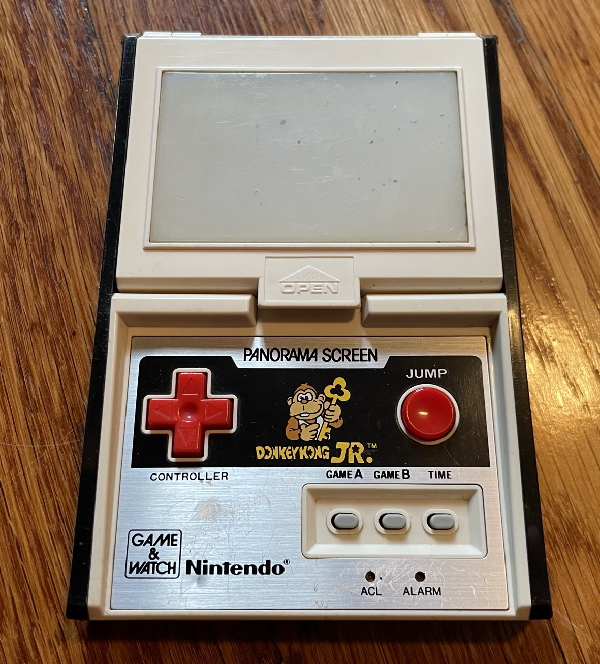Too Good to be First-Party: Coleco's Tabletop Donkey Kong Junior
What was home video gaming like in the early 1980’s? You might consider picturing things like the Atari 2600 or the Intellivision, and those were certainly a big part of it. But another big part were the category I’ll call segmented-display games; portable systems like the Game & Watch, but also more stationary “portable arcade” machines. And in the United States, no name in home mini-arcades was bigger than that of the Connecticut Leather Company, or if you’re a friend, Coleco.
Not made of leather

The Coleco Mini-Arcade line were a big deal. In 1982, Electronic Games magazine reported that Coleco was reporting initial advance sales orders of over 4 million for the first four games in its series alone, with 1.5 million units of Pac-Man sold already. Note that at the time of this article two of those four games weren’t even out yet, and even more were added later on. Four million units is more than consoles like the ColecoVision or the Sega SG-1000, nothing to sneeze at.
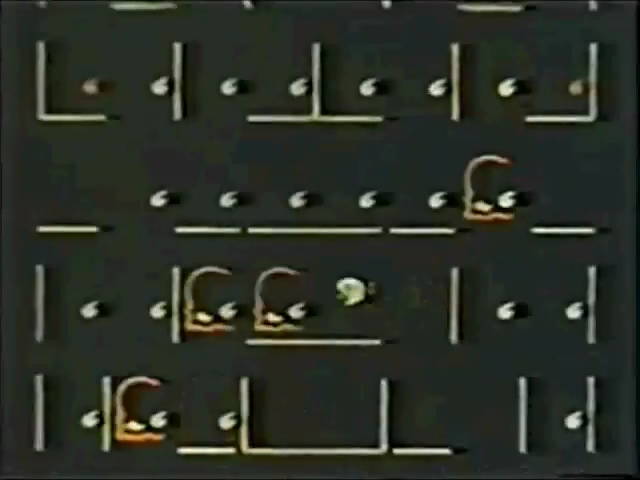
The technology most of these used were vacuum flourescent displays. These are pretty nice-looking and give off their own light, but beyond that are segmented displays similar to LCD watches (or Game & Watches, spoiler) of the same time period. You might be more familiar with them on stereo equipment, like my 1986 Technics SL-PJ33 CD player.
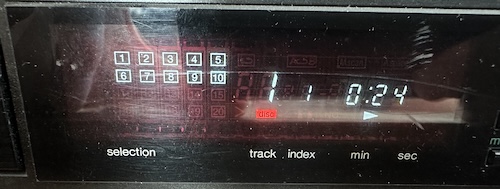
By the way, did you know many of these are in MAME now? Here’s Donkey Kong. It even includes a form of the rivet stage; is it really a worse way to play Donkey Kong than, say, the Atari 2600 version? And at the time of this writing, segmented display versions of Pac-Man like that 1.5 million-seller are still available today for next-day delivery on monopolistic internet marketplaces. (Not an affiliate link, so go use someone else’s and give them money) Evidently, this is “CLASSIC PAC-MAN AT IT’S BEST”.
So I decided I had to get one of these Colecos.
Donkey Kong Jr.
I decided to go for Donkey Kong Jr., also known as Donkey Kong Junior. After all, my Donkey Kong Jr. arcade PCB is still converted to instead play Hero in the Castle of Doom.
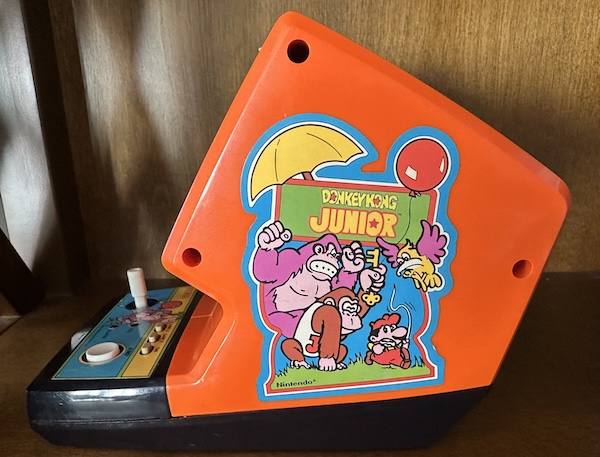
And I have to say I love the look of the Donkey Kong Junior tabletop here. With the pastel aesthetic and its large size, it really stands out on a shelf. Not to imply all the stuff I buy just sits on shelves. I play games a lot, really!
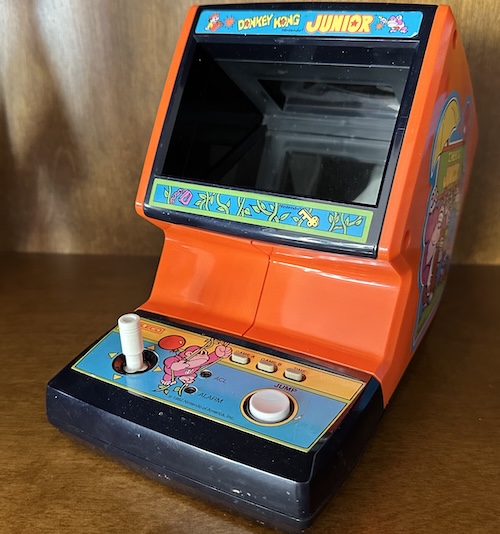
The aesthetic continues on the front. I think the looks were a big part of the appeal of the Coleco tabletops; it’s a substantial-looking machine with arcade-like decorations. Sure, you’re playing a game on a segmented display of the sort used mostly for basic seven-segments numerics, but the experience is everything around it, with the joystick, the large jump button, and yes, the cabinet art.
So why don’t we turn on the game? Well, you see, the game is already on. I’ve fallen for a trick again; unlike Coleco’s Donkey Kong, Pac-Man, or any of the others, this isn’t a VFD display at all! Indeed, it’s lit by a translucent panel on the back of the machine; you need to have some sort of light source hitting it.
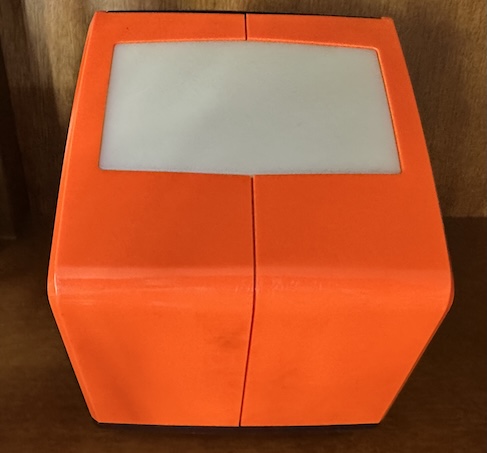
And that might sound familiar. Like something else we’ve seen on this blog before; something else that can also play some kind of game called Donkey Kong Jr.– the Game & Watch Panorama Series.
Coleco turned to Nintendo themselves to make this machine. It’s differently shaped than the other Coleco home arcades and not VFD because it’s just a rebadged and recolored version of Nintendo’s Game & Watch Tabletop game Donkey Kong Jr. (If you want to play it for yourself, there’s a pretty decent recreation on Itch.)
And that’s not a bad thing!
As I noted on the Panorama Screen article, this is actually one of the best-looking games out there. And the Tabletop form factor makes it look even better; let’s put this behind some sunlight.
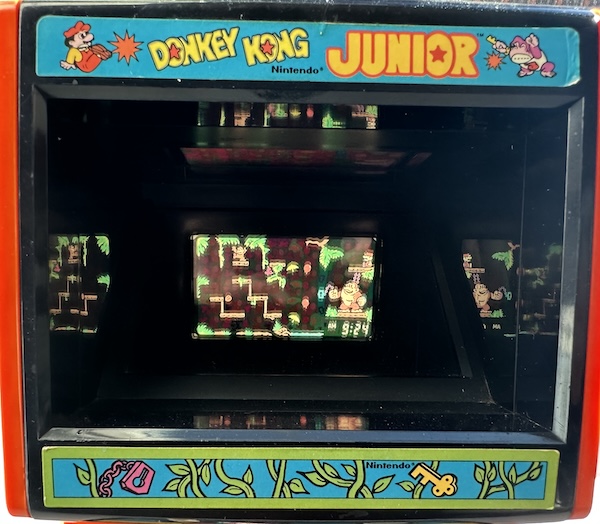
That might be a little too much color. But it shows the point– this isn’t the crude shapes of the VFD games; this is a full-color art. It also shows that the game here is the same as the panorama screen. Look at my previous article for more details, Nintendo made no less than three LCD games out of Donkey Kong Jr., and this one reflects some of the gameplay elements of stage 2 of the arcade, adapted for a horizontal screen.
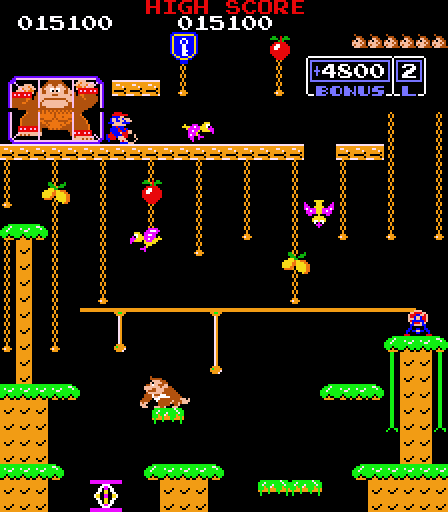
The tabletop form factor also lets us get a really good view of the colorization sheet mounted at an angle.
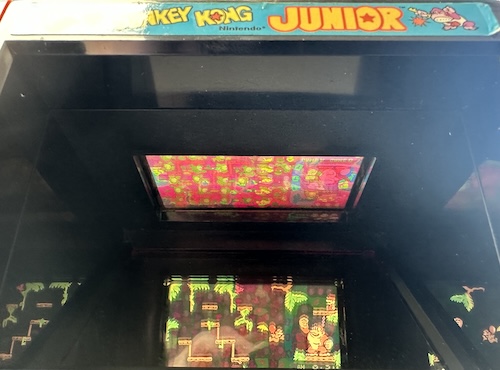
By the way, take a closer look at the control panel.
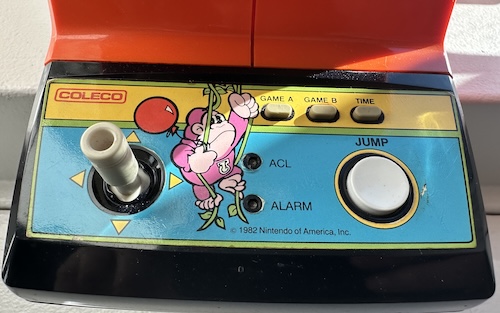
Why is that one button labeled ‘ACL’? The manual notes that it’s the button used to reset the time, and will also reset your high scores, but doesn’t say more than that, like why it’s called that.
Well, the Game & Watch titles, tabletop and panorama included, used a Sharp 4-bit microprocessor. Let’s take a look at the manual to see if it can find any clues. It turns out it’s “Auto CLear”, and we even see a possible circuit for using it to reset.
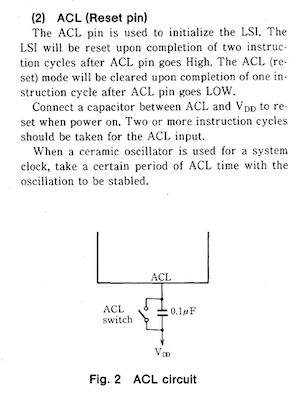
This gives some clues to how the program works; it boots up in time-setting mode. As a Game & Watch, it never turns off; the high score is only remembered because the low-power microprocessor keeps its RAM always charged. 128 4-bit words of RAM (64 bytes), even. The only way left to change that is to reset it, which also causes it to initialize the RAM again.
You might wonder now about the Soviet Game & Watch I covered a few years ago. While Egg/Mickey Mouse, part of the Wide Screen series, did have buttons labeled “ALARM” and “ACL” just like Donkey Kong Junior here, the Soviet clone used icons instead. A notable improvement, I’d say.
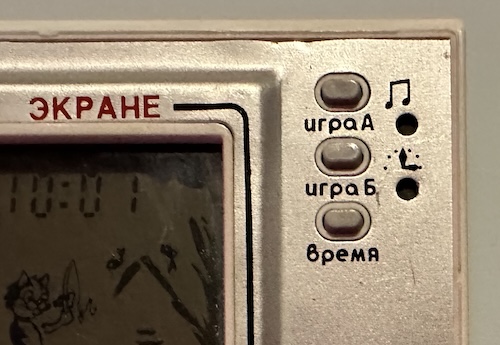
But… why?
There is something interesting here. The Coleco Tabletop arcades, as I noted, were quite successful for their time. But the Game & Watch Tabletops, on the other hand, were flops– the Panorama Screen was introduced to try to give the line some surviving form. I can’t find any precise sales numbers, but judging by eBay sales, I wouldn’t be surprised if the Coleco version of Donkey Kong Junior substantially outsold its Nintendo-branded version.
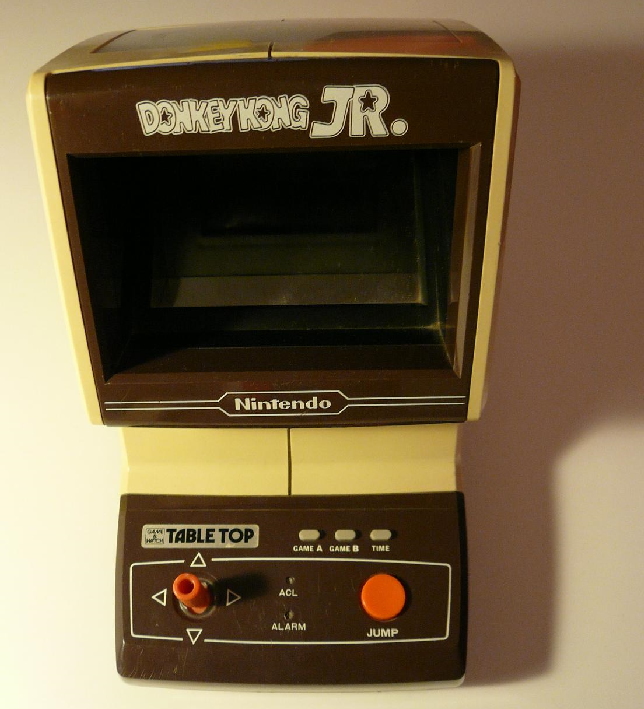
So why might that be? Well, there’s a few things to keep in mind here. The first was that Coleco in the early 1980’s was a titan of the toy industry, with a huge marketing budget. What else were they putting out in 1982? A little line of dolls called Cabbage Patch Kids. This was a company at their peak. (Which certainly wouldn’t burn itself out in just a few years!) Meanwhile, Nintendo, despite its various dalliances, was much smaller in the toy business, especially outside of Japan.

Secondly, I think how these were marketed played a big role. Coleco aggressively marketed its tabletop machines with one goal in mind: this was how you could play the big-name arcade video games in your home. The game titles were licensed big names like Donkey Kong, Pac-Man, Ms. Pac-Man, Frogger, and Galaxian, and the VFD games attempted to simulate those, with surprisingly decent success considering.
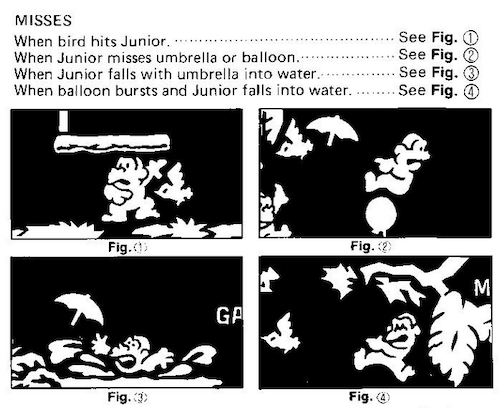
Nintendo, meanwhile, treated tabletops as a larger version of their portable on-the-go line, relying on non-video game licenses like Snoopy and Popeye. Donkey Kong Jr. was the most arcade-like of the bunch (and diverged from its source material significantly); Mario’s Cement Factory didn’t share gameplay with any other game with Mario. These failed to capture the arcade-at-home market Coleco targeted, and were too bulky to hit the gaming-on-the-go sweet spot of other Game & Watch titles. (Panorama fixed that, which is probably why that line lasted longer)
Really, though, we all know it’s because Nintendo didn’t include that beautiful pastel side art.

